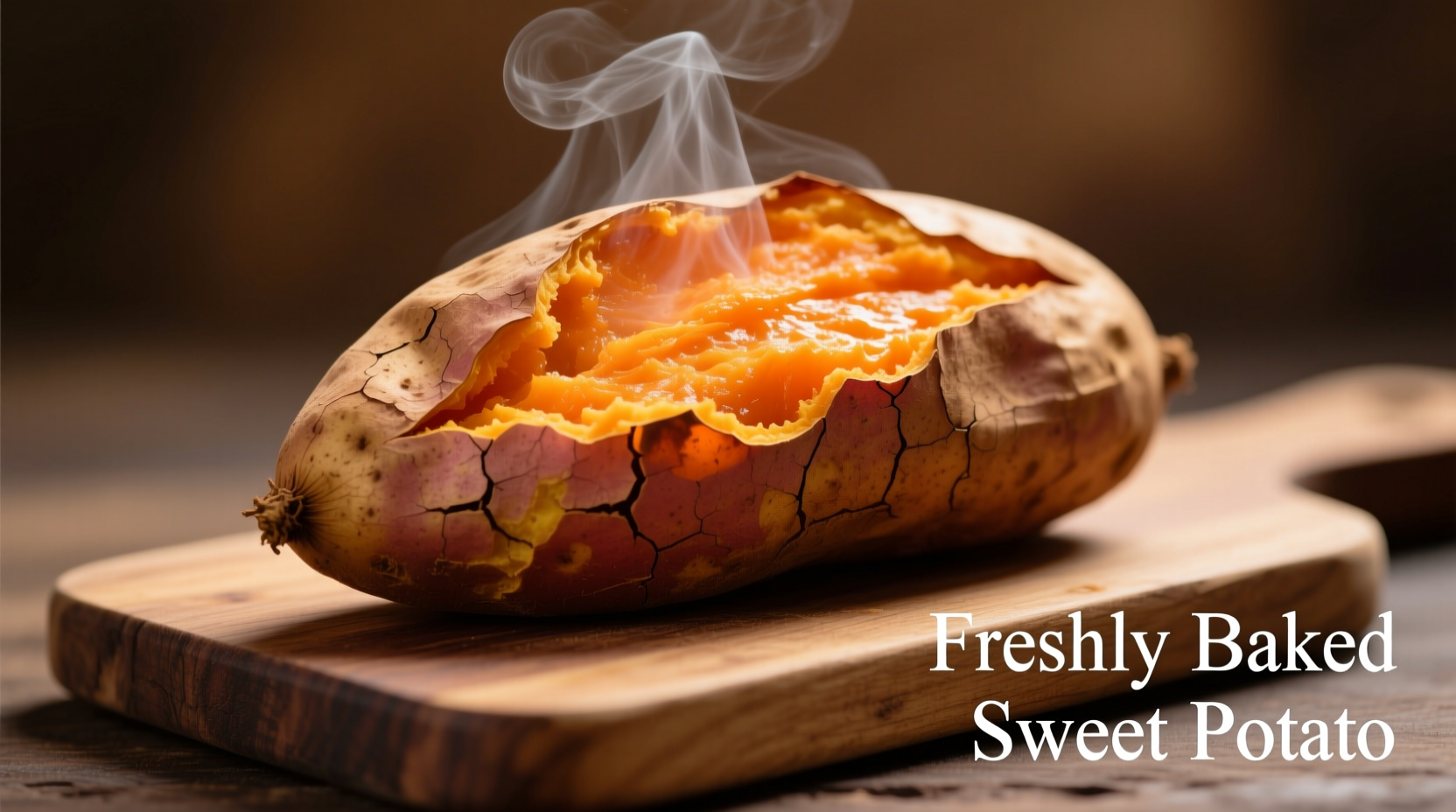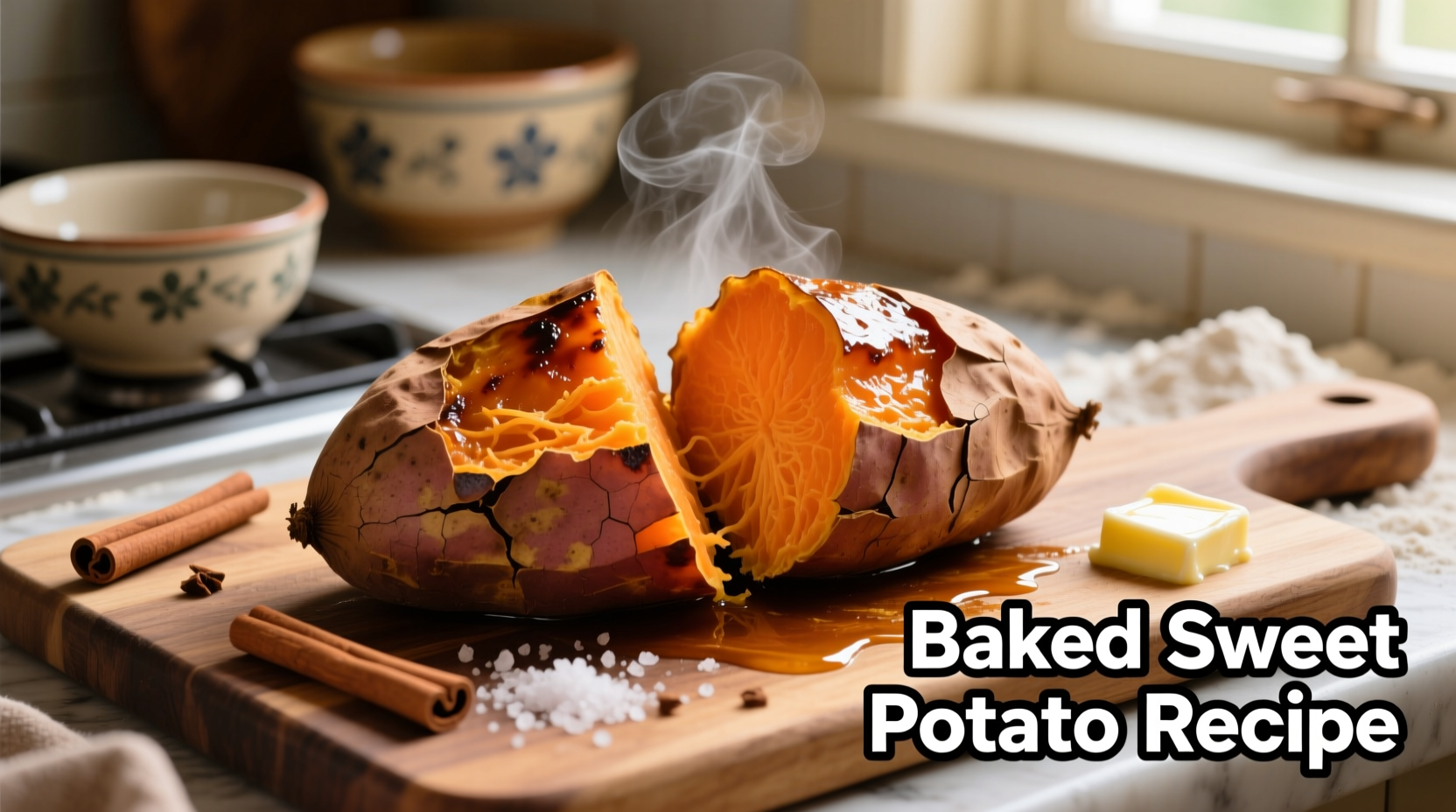Nothing beats the natural sweetness and creamy texture of a perfectly baked sweet potato. Unlike boiling or microwaving, oven baking concentrates flavors and creates that ideal balance of slightly crisp skin and melt-in-your-mouth flesh. Whether you're meal prepping, looking for a healthy side dish, or craving a simple dessert, this method delivers consistent results without special equipment.
Why Oven Baking Beats Other Methods
While microwaving offers speed and boiling preserves nutrients, oven baking creates superior flavor development through caramelization. The dry heat of your oven concentrates natural sugars in sweet potatoes, creating complex flavor notes you won't get with other cooking methods. Professional chefs prefer this technique because it requires minimal intervention while producing restaurant-quality results.
| Cooking Method | Time Required | Flavor Development | Texture Result |
|---|---|---|---|
| Oven Baking | 45-60 minutes | ★★★★★ (Excellent caramelization) | Crisp skin, creamy interior |
| Boiling | 20-30 minutes | ★★☆☆☆ (Water dilutes flavors) | Uniformly soft, sometimes waterlogged |
| Microwaving | 5-12 minutes | ★★★☆☆ (Good but less complex) | Soft throughout, no textural contrast |
What You'll Need
- Sweet potatoes (any variety - Garnet, Jewel, or Hannah work well)
- Baking sheet (optional, for catching drips)
- Fork or skewer
- Oven mitts
- Meat thermometer (optional but helpful)
Step-by-Step Baking Instructions
Preparation Phase (5 minutes)
- Choose quality potatoes: Select firm sweet potatoes without soft spots or deep bruises. Medium-sized potatoes (5-8 ounces) cook most evenly.
- Clean thoroughly: Scrub potatoes under cool running water using a vegetable brush to remove dirt. Pat dry with a clean towel.
- Prick the skin: Use a fork to pierce the skin 4-6 times per potato. This prevents steam buildup that could cause bursting.
- Optional enhancement: For extra flavor, rub potatoes lightly with olive oil and sprinkle with sea salt before baking.
Cooking Phase (45-60 minutes)
- Preheat oven: Set to 400°F (200°C) and allow to fully preheat (about 15 minutes).
- Position potatoes: Place directly on the middle oven rack with a baking sheet on the rack below to catch any drips.
- Bake until tender: Cook for 45-60 minutes, depending on size. Larger potatoes may need up to 75 minutes.
- Check for doneness: Potatoes are ready when a fork slides in easily and the internal temperature reaches 205-210°F (96-99°C).
Serving Phase (Immediate)
- Cool slightly: Let potatoes rest for 5-10 minutes (they'll continue cooking internally).
- Make an opening: Cut a slit lengthwise across the top and gently squeeze the ends toward the center.
- Add finishing touches: Top with butter, cinnamon, or your favorite toppings while the potato is still hot.

When This Method Works Best (And When to Choose Alternatives)
Oven baking shines when you want maximum flavor development and textural contrast. However, certain situations call for different approaches:
- Meal prep: Bake multiple potatoes at once and refrigerate for up to 5 days. Reheat in oven for best texture.
- Time constraints: For quicker results, microwave for 5 minutes then finish in a 400°F oven for 15-20 minutes.
- Large gatherings: Bake at 375°F for 60-75 minutes to accommodate more potatoes without overcrowding.
- Humid climates: Extend baking time by 10-15 minutes as moisture in the air affects cooking.
Avoid These Common Mistakes
- Skipping the pricking step: Without venting holes, steam buildup can cause potatoes to burst.
- Wrapping in foil: This steams rather than bakes the potato, resulting in soggy skin and less flavor development.
- Undercooking: Sweet potatoes must reach 205°F internally to fully convert starches to sugars.
- Overcrowding the oven: Leave space between potatoes for proper air circulation.
Nutritional Benefits of Properly Baked Sweet Potatoes
According to USDA FoodData Central, a medium baked sweet potato (130g) provides 103 calories, 24g carbohydrates, and an impressive 375% of your daily vitamin A needs. The baking process actually increases the bioavailability of beta-carotene compared to raw sweet potatoes. The FDA recommends including sweet potatoes in balanced diets due to their high fiber content and low glycemic index when prepared without added sugars.
Storage and Reheating Tips
Store cooled baked sweet potatoes in airtight containers in the refrigerator for up to 5 days. For best results when reheating:
- Oven method: 375°F for 15-20 minutes (best for texture retention)
- Quick option: Microwave on 50% power for 2-3 minutes
- Avoid: Reheating at high temperatures which can make potatoes tough
Frequently Asked Questions
How do I know when my sweet potato is fully baked?
Your sweet potato is fully baked when a fork or skewer slides in easily with no resistance. For precise results, use an instant-read thermometer - the internal temperature should reach 205-210°F (96-99°C). The skin will appear slightly shrunken and may have some caramelized spots where natural sugars have leaked out and roasted.
Can I bake sweet potatoes without pricking them?
While possible, we strongly recommend pricking sweet potatoes with a fork before baking. Without venting holes, steam builds up inside the potato during cooking, which can cause it to burst open in the oven. This creates a mess and can lead to uneven cooking. Four to six evenly spaced pricks are sufficient for medium-sized potatoes.
Why shouldn't I wrap sweet potatoes in foil when baking?
Wrapping sweet potatoes in foil creates a steaming environment rather than allowing dry heat to bake the potato. This results in soggy skin and less flavor development, as the natural sugars can't caramelize properly. The University of Illinois Extension specifically advises against foil wrapping for baked sweet potatoes, noting it extends cooking time by 20-30% and produces inferior texture compared to direct oven exposure.
How can I speed up the baking process without sacrificing quality?
For faster results while maintaining good texture, microwave the potatoes for 5 minutes first, then finish in a 400°F oven for 15-20 minutes. This partial cooking reduces total time while still allowing the dry heat of the oven to develop flavor and texture. Alternatively, slice larger potatoes in half lengthwise before baking, which cuts cooking time nearly in half while increasing caramelized surface area.
What's the best way to store leftover baked sweet potatoes?
Store cooled baked sweet potatoes in airtight containers in the refrigerator for up to 5 days. For longer storage, freeze whole or mashed potatoes in freezer-safe containers for up to 6 months. When reheating, the oven method (375°F for 15-20 minutes) preserves texture best, while microwaving can make them tough if done at full power. Always reheat until the internal temperature reaches 165°F for food safety.











 浙公网安备
33010002000092号
浙公网安备
33010002000092号 浙B2-20120091-4
浙B2-20120091-4